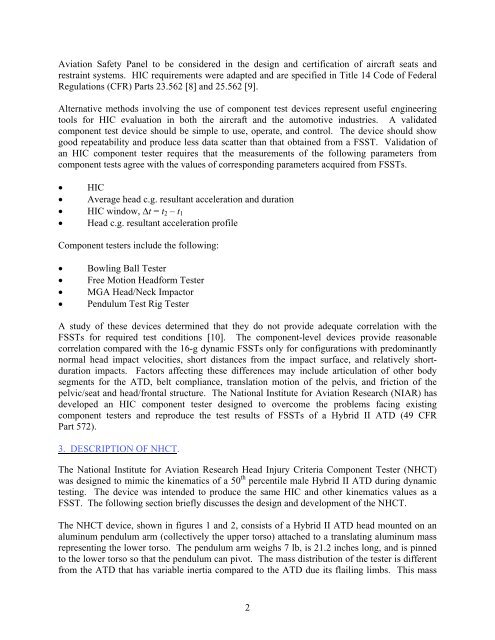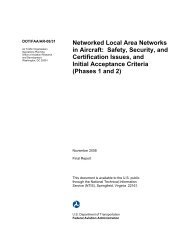Development of a Component Head Injury Criteria (HIC ... - FAA
Development of a Component Head Injury Criteria (HIC ... - FAA
Development of a Component Head Injury Criteria (HIC ... - FAA
You also want an ePaper? Increase the reach of your titles
YUMPU automatically turns print PDFs into web optimized ePapers that Google loves.
Aviation Safety Panel to be considered in the design and certification <strong>of</strong> aircraft seats and<br />
restraint systems. <strong>HIC</strong> requirements were adapted and are specified in Title 14 Code <strong>of</strong> Federal<br />
Regulations (CFR) Parts 23.562 [8] and 25.562 [9].<br />
Alternative methods involving the use <strong>of</strong> component test devices represent useful engineering<br />
tools for <strong>HIC</strong> evaluation in both the aircraft and the automotive industries. A validated<br />
component test device should be simple to use, operate, and control. The device should show<br />
good repeatability and produce less data scatter than that obtained from a FSST. Validation <strong>of</strong><br />
an <strong>HIC</strong> component tester requires that the measurements <strong>of</strong> the following parameters from<br />
component tests agree with the values <strong>of</strong> corresponding parameters acquired from FSSTs.<br />
• <strong>HIC</strong><br />
• Average head c.g. resultant acceleration and duration<br />
• <strong>HIC</strong> window, Δt = t 2 – t 1<br />
• <strong>Head</strong> c.g. resultant acceleration pr<strong>of</strong>ile<br />
<strong>Component</strong> testers include the following:<br />
• Bowling Ball Tester<br />
• Free Motion <strong>Head</strong>form Tester<br />
• MGA <strong>Head</strong>/Neck Impactor<br />
• Pendulum Test Rig Tester<br />
A study <strong>of</strong> these devices determined that they do not provide adequate correlation with the<br />
FSSTs for required test conditions [10]. The component-level devices provide reasonable<br />
correlation compared with the 16-g dynamic FSSTs only for configurations with predominantly<br />
normal head impact velocities, short distances from the impact surface, and relatively shortduration<br />
impacts. Factors affecting these differences may include articulation <strong>of</strong> other body<br />
segments for the ATD, belt compliance, translation motion <strong>of</strong> the pelvis, and friction <strong>of</strong> the<br />
pelvic/seat and head/frontal structure. The National Institute for Aviation Research (NIAR) has<br />
developed an <strong>HIC</strong> component tester designed to overcome the problems facing existing<br />
component testers and reproduce the test results <strong>of</strong> FSSTs <strong>of</strong> a Hybrid II ATD (49 CFR<br />
Part 572).<br />
3. DESCRIPTION OF NHCT.<br />
The National Institute for Aviation Research <strong>Head</strong> <strong>Injury</strong> <strong>Criteria</strong> <strong>Component</strong> Tester (NHCT)<br />
was designed to mimic the kinematics <strong>of</strong> a 50 th percentile male Hybrid II ATD during dynamic<br />
testing. The device was intended to produce the same <strong>HIC</strong> and other kinematics values as a<br />
FSST. The following section briefly discusses the design and development <strong>of</strong> the NHCT.<br />
The NHCT device, shown in figures 1 and 2, consists <strong>of</strong> a Hybrid II ATD head mounted on an<br />
aluminum pendulum arm (collectively the upper torso) attached to a translating aluminum mass<br />
representing the lower torso. The pendulum arm weighs 7 lb, is 21.2 inches long, and is pinned<br />
to the lower torso so that the pendulum can pivot. The mass distribution <strong>of</strong> the tester is different<br />
from the ATD that has variable inertia compared to the ATD due its flailing limbs. This mass<br />
2

















